Key Takeaways
- Chile spans varied landscapes, from icy Andean summits to dry desert plains and windy coastlines.
- Its cultural traditions reflect a blend of indigenous influences and historic legacies.
- Architecture, crafts, and local festivals highlight a range of hues that echo Chile’s unique climate zones.
- Knowing Chile’s history, regional customs, and color-themed traits can enrich your travel and learning experience.
- Practical tips and an awareness of local norms help travelers fully enjoy this long, narrow nation.
Introduction
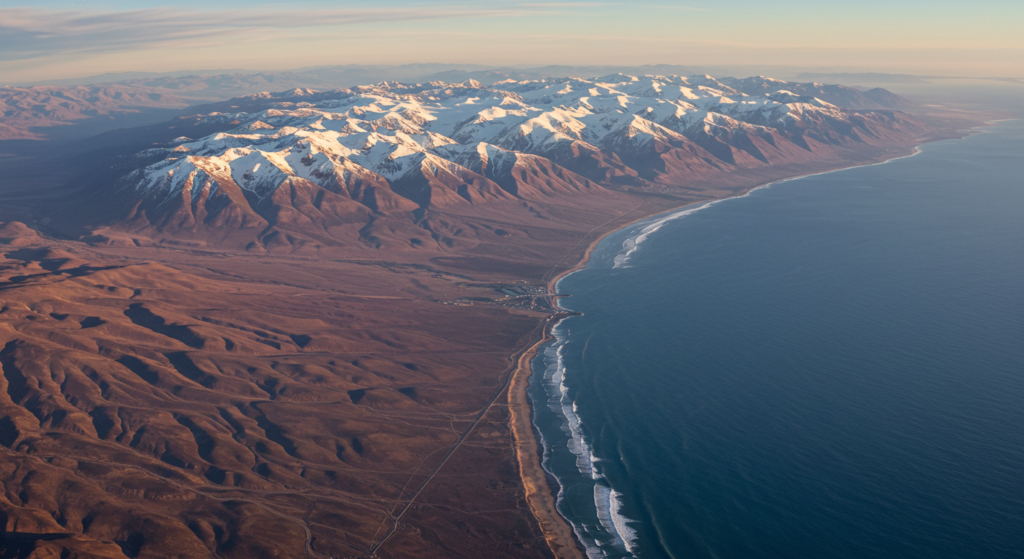
Chile stretches along South America’s western edge, hugging the Pacific Ocean and nudging the Andes. Its narrow shape includes snow-capped peaks, harsh deserts, bustling cities, and lush valleys. Many travelers are drawn by the immense variety, which shifts from north to south in dramatic ways. Ask yourself: how does one country fit so many extremes?
This article explores Chile’s colorful tapestry. We will look at mountain whites, desert neutrals, and deep blues. We will also see how these colors connect with the country’s architecture, festivals, crafts, and daily life. Chile’s storyline involves indigenous communities, colonial changes, independence movements, and modern transformations. Each leaves a mark on the nation’s identity.
If you want historical anecdotes, cultural insights, and practical pointers, keep reading. You will find a wide range of details that paint a picture of Chile’s complexity. At the end, a summary table will simplify your notes. Then, a FAQ section will tackle common questions about this Andean land.
A Land of Diversity
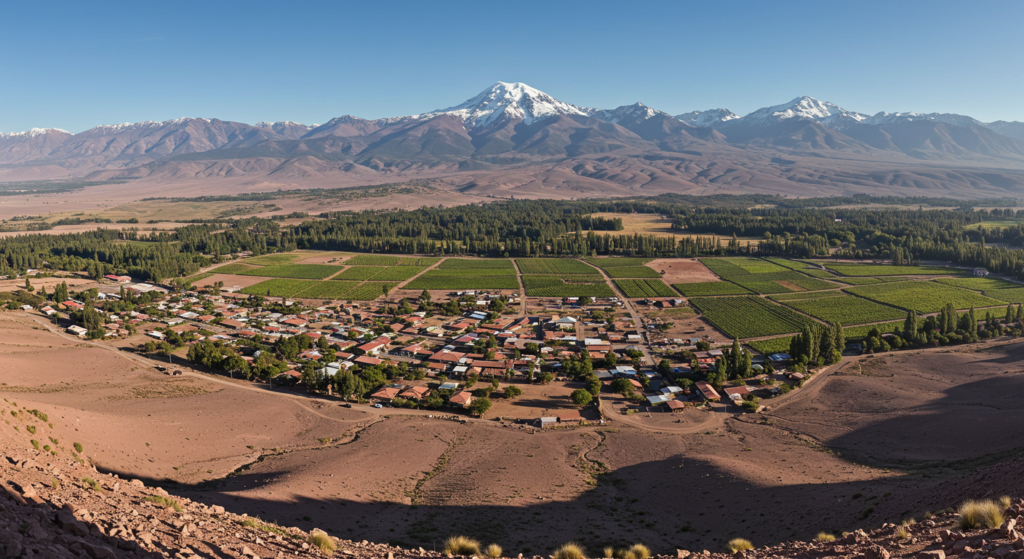
Ancient Roots
Before the colonial era, diverse indigenous groups inhabited Chile’s valleys, coasts, and mountain foothills. Some, like the Mapuche, resisted outside rule for centuries. Others traded across the Andes, exchanging goods with neighboring territories. Trade routes promoted regional ties and nurtured unique traditions.
Archaeological finds reveal hints of fishing communities on Chile’s coast from prehistoric times. Inland, farming practices adapted to the Andes’ slopes, shaping agricultural terraces. Each group valued local materials and used them in ceramics, clothing, or daily tools. Over time, these items fused into a cultural mosaic.
Woven artifacts often included earthy tones. Early potters created vessels with subtle patterns that reflected their environment. The idea of color was not simply for decoration. It served as a cultural statement, linking families to certain lineages or spiritual customs.
Geographical Extremes
Chile’s length runs from Peru’s border in the north down to the icy tip of South America. Along that journey, temperatures and landscapes shift. The Atacama Desert’s dryness contrasts with the lush Lake District, and the southern fjords present a colder, misty realm.
Four main zones frame the scene. The north is hot and stark, with sparse vegetation and miles of salt flats. The center holds major cities like Santiago, cradled by towering peaks. The south features forests and glacial lakes. Farther south, windswept Patagonia meets the end of the continent.
These extremes shape the daily life of locals. Farmers in the north learn to irrigate, relying on underground water sources. Coastal dwellers form communities around fishing, while mountainous areas thrive on herding and adventure tourism. Each zone shines with distinct color palettes, from desert neutrals to icy whites.
Cultural Mosaic
Chile’s culture includes Indigenous, European, and other influences. Migration from Europe swelled during the late 19th and early 20th centuries. Settlers arrived with new building styles and technology, merging them with local crafts. That blend took root, creating modern Chilean identity.
Today, you will find a wide range of music, art, and culinary offerings. Traditional folk dances celebrate rural life, while contemporary pop engages global trends. Urban centers feature cutting-edge restaurants, but small towns keep time-honored cooking alive.
Artisan markets often showcase bright woven fabrics. In mountainous areas, people wear ponchos or thick garments with geometric designs. Along the coast, items might lean toward blues and whites. The result is a patchwork of local styles that differ from place to place, yet all belong under Chile’s banner.
Mountain Whites: The Andes at a Glance
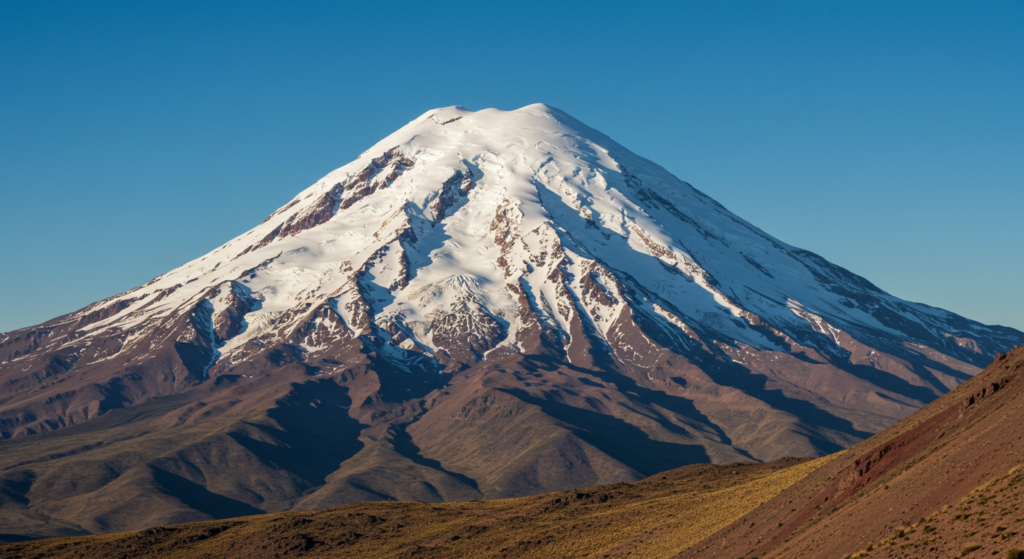
High Elevations
The Andes form a formidable spine along Chile’s eastern frontier. Peaks like Ojos del Salado, one of the world’s tallest volcanoes, tower in the north. Farther south, volcanic activity shapes landscapes and fosters fertile soils.
At high altitudes, snow and ice remain year-round on certain summits. Glaciers persist in remote stretches, carving valleys and feeding rivers. Adventurers seek these terrains for climbing or trekking. The stark whiteness of Andean peaks has become a symbol of Chile’s rugged spirit.
Mountain passes often serve as lifelines between regions. They link farming areas to trade hubs, bridging cultures. Routes over the peaks reveal panoramic views of shining snowfields, sharp ridges, and hidden lagoons. In many spots, local folklore connects these summits with legends of guardians or spirits.
Snow and Ice
Chile’s snowy slopes lure winter sports enthusiasts. Ski resorts cluster near Santiago and further south. These facilities combine modern amenities with scenic vistas. Powdery snow drapes the runs, drawing families and adrenaline seekers each winter. Clear skies can provide glimpses of distant plains while you glide downhill.
Beyond leisure, these frozen expanses hold important water reserves. Melting snow replenishes rivers that supply agriculture, industry, and households. Hydroelectric plants harness their power for electricity. In drought years, reduced snowpack can trigger water shortages, a concern for farmers in many valleys.
Glacier retreats in southern zones reveal the delicate balance of Chile’s ecosystem. Cracking icebergs highlight changing conditions, and local researchers monitor these shifts. Some protected areas welcome visitors who wish to see turquoise-hued ice, an awe-inspiring sight in the remote corners of Patagonia.
Andean Traditions
Andean culture infuses local festivals, crafts, and daily routines. In some villages, people weave alpaca wool into blankets and cloaks to stay warm against the cold. The thick fiber traps heat and reflects the mountain’s spirit. Music in these areas may feature pan flutes, charangos, and other instruments with ancient ties.
Festivals might celebrate a harvest or a religious occasion. Parades wind through narrow streets, and masked dancers present step patterns taught over generations. White garments, reminiscent of snowy peaks, show up in ceremonial attire. Even the mountains appear to join the festivities, looming in the background.
These traditions endure for a reason. They foster community bonds and pass on knowledge through music, dance, and shared symbols. Locals understand that living near the Andes requires resourcefulness. Celebrations remind everyone of their unity and their roots.
Desert Neutrals: The Atacama
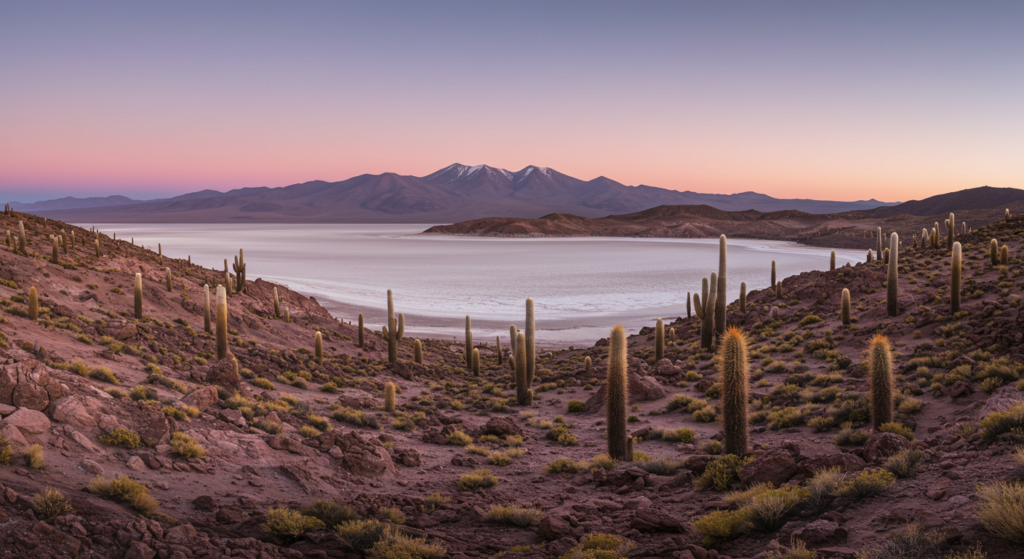
Arid Landscapes
In Chile’s north lies the Atacama Desert, one of the driest places on Earth. Some regions see almost no rainfall. Soil in many spots holds salt deposits, creating glimmering flats. Rock formations look otherworldly, with colors that shift between beige, tan, and a faint pink at sunrise.
Travelers cross barren expanses and gaze at towering dunes. Nighttime reveals a star-studded sky with unparalleled clarity. Astronomy observatories operate in this region, helped by minimal light pollution. Large telescopes study the cosmos, advancing our understanding of the galaxy.
Water sources in the Atacama remain scarce. Local towns rely on wells or small rivers that descend from the Andes. Farming here focuses on select crops that adapt to dryness, like quinoa or certain desert shrubs. People who live in these harsh landscapes have built a unique resilience shaped by sand and stone.
Historic Settlements
In the past, caravans and trade routes wound through the Atacama, linking Chile to neighboring lands. Towns sprouted around oases or mineral veins. Mining boomed in the 19th century, sparked by nitrate deposits. Northern Chile’s prosperity grew with it, yet many mining towns later declined.
Today, some ghost towns stand deserted, but they tell stories of a dynamic past. Rusted train tracks, abandoned warehouses, and old saloon buildings remind visitors of a once-thriving economy. In some spots, restoration efforts preserve these sites as open-air museums.
Modern tourism also plays a role. People flock to places like San Pedro de Atacama to see geysers, salt flats, and moon-like valleys. Adobe structures blend into sand-colored surroundings, merging with the desert’s neutral palette. Signs of life are subtle but persistent, revealing the human knack for adaptation.
Desert Flora and Fauna
Though the Atacama seems lifeless at first glance, certain species flourish in these conditions. Microbial colonies thrive in high-salinity ponds, lending them a pink hue. Desert foxes roam at dusk, searching for small rodents. When rare rains fall, hidden seeds bloom, painting the desert in sudden bursts of color.
Cacti and desert shrubs manage water carefully. Some store moisture in thick stems. Others open pores only at night. This approach allows them to survive under scorching sun and cold nights. Over time, people observed these plants and learned to gather them for medicinal or nutritional needs.
Wildlife must adapt too. Vicunas graze on sparse grass near Andean foothills. Flamingos wade in salt lagoons, filtering brine shrimp through their beaks. These flamingos, dusted in pastel pink, offer one of the few spots of bright color in an otherwise muted place.
Pacific Blues: Coastline Wonders
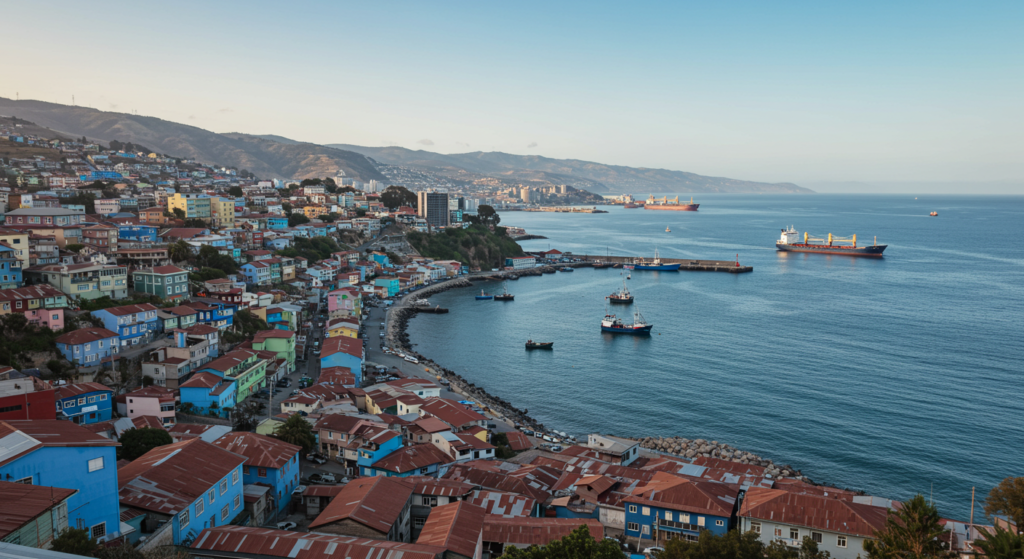
Northern Shores
Chile’s northern coast near Iquique and Arica features warm beaches and trade ports. Blue waters meet golden sand. Fishing vessels dock at piers, unloading their catch of the day. An entire economy revolves around the sea, from local seafood restaurants to large-scale export operations.
Surfing thrives in certain parts of the north. Steady swells offer consistent waves. Sunlit beaches attract enthusiasts who relish the desert-coast combo. Inland, the parched hills rise, forming a stark contrast with the vibrant coastline. You can enjoy fresh fish tacos, then trek into the dryness within a few miles.
Local heritage shapes cultural events. Maritime festivals often honor saints believed to protect sailors. Neighborhoods gather at the beach or harbor, and processions highlight fishermen’s ties to these waters. Blue, in this area, symbolizes bounty and a sense of possibility.
Central Hubs
As you move south, central ports like Valparaíso and San Antonio come into view. Valparaíso, a UNESCO World Heritage Site, climbs steep hills. Colorful houses line winding streets, and funicular railways carry people from shore to hilltops. Street art brightens walls, reflecting a creative spirit.
Pacific blues shine in the bay, where ships anchor and seagulls float overhead. Markets sell fresh seafood. Local dishes include shellfish stews or succulent fish plates. The city’s bohemian vibe draws poets and painters who find inspiration in the ocean’s rhythms.
Santiago sits inland, but it connects to Valparaíso by road, making day trips easy. Many residents escape the capital’s bustle on weekends, seeking coastal breezes. They might stroll the seaside promenade or hop on a boat tour to see sea lions and harbor seals. The central coast becomes a shared backyard for many urban dwellers.
Southern Inlets
Farther down, the coastline grows wild, with fjords, channels, and islands. Fishing towns nestle beside icy waters. The Chiloé Archipelago stands out for its wooden churches and stilt houses. Locals rely on the sea for livelihood, venturing out in small boats to harvest mussels or seaweed.
Storms can sweep in from the Pacific, lashing the shores with wind and rain. This watery realm invites explorers who seek hidden coves and scenic hikes through evergreen forests. The interplay of ocean and forest fosters a distinct culture tied to myths of ghost ships and forest spirits.
Oceanic blues shift with the weather. Sometimes they appear grayish under cloud cover, then shift to dazzling blue when the sun reappears. Fishing communities adapt to these fluctuations. They mend nets, maintain lighthouses, and keep alive traditions that hinge on the sea’s constant presence.
History Beyond the Andes

Colonial Milestones
Spanish explorers arrived in Chile during the 16th century. Their quest for territory led to conflicts with native peoples. Settlements expanded along fertile valleys, and colonies took root. Catholic missions introduced new beliefs, but also disrupted local customs.
Large estates, or haciendas, shaped early agriculture. Wheat, grapes, and livestock fed domestic needs and external trade. The economy grew, yet tensions simmered. Indigenous uprisings and regional disputes tested colonial power. Spanish structures, including churches and government buildings, often used adobe or stone, blending with the existing environment.
Architectural details from that period still stand in certain historic centers. Wooden balconies and courtyards reflect Spanish influence, while local craftsmanship remains visible in decorative touches. Over time, the blending of cultures produced new forms of music, dance, and storytelling.
Independence Movements
Chile’s path to independence gained momentum in the early 19th century. Figures like Bernardo O’Higgins led campaigns that challenged colonial rule. Battles raged across valleys and mountain passes, culminating in formal separation from Spain.
The newly formed Republic of Chile then focused on nation-building. Government leaders encouraged education and infrastructure. Trade routes expanded, and immigrants arrived from Europe. Cities like Valparaíso became bustling ports, connecting Chile to global markets. A sense of national identity took shape, tied to the flag’s red, white, and blue.
Though independence created opportunities, many sectors of society faced inequalities. Land ownership remained concentrated, and indigenous communities continued struggles for recognition. Still, the spirit of progress endured. Railways, telegraphs, and roads connected scattered regions, uniting a long country under one government.
Modern Shifts
The 20th century brought fresh waves of reform and challenges. Industrialization spurred urban migration. Workers demanded better rights, leading to significant political movements. Military rule at certain periods disrupted civil liberties, leaving a deep mark on society.
With the return of democracy, Chile turned a page. New policies spurred growth. Free trade agreements connected Chile’s products with the world. Exports like copper, wine, and fruits gained wide attention. Education reforms tried to broaden access, though debates continued about equity.
Modern Chile invests in technology, renewable energy, and tourism. Cities adopt modern high-rises, yet older neighborhoods keep cobblestone streets and classical facades. The combination of past and present shapes a distinctive identity. Chile looks outward, yet remains rooted in its heritage.
Colors of Architecture

Urban Contrasts
Major Chilean cities feature concrete towers, glass facades, and colonial-era buildings. In Santiago’s historic quarter, palaces and cathedrals stand near modern offices. This creates a visual patchwork. Some older walls display muted tones. Next door, sleek steel structures reflect sunlight with bright intensity.
Street art also sparks contrast. Murals transform bland walls into canvases of color. Districts like Bellavista in Santiago or Cerro Alegre in Valparaíso highlight creative designs. Abstract shapes or cultural references fill entire blocks. Such art fosters pride and fosters a sense of community.
Renovation efforts balance preservation and innovation. Restoring old government buildings aims to keep their historical essence. Meanwhile, new architects experiment with green rooftops and energy-efficient materials. These projects prove how a modern metropolis can hold onto its past while shaping the future.
Coastal Hamlets
Small fishing villages scatter along Chile’s coast. Houses often use simple wood or corrugated metal, painted in soft pastels or bright shades. In some places, siding materials protect against salty air and strong winds. Locals choose practical solutions, yet they add charm with splashes of color.
Boats at the docks sometimes match the homes. When moored, the entire bay becomes a kaleidoscope of painted surfaces. Residents pay attention to small details. Blue trim around windows might echo the sea’s hue. Red roofs can stand out against a cloudy sky.
Community gathering points, such as a town square or church, add visual interest. These sites often have a fresh coat of paint. Seasonal festivals bring banners and flags that wave in the ocean breeze. Even battered walls can seem cheerful in the right light.
Rural Structures
Further inland, farming areas rely on adobe houses and wooden barns. Earthy browns and faded whites blend with farmland. Courtyards let families gather outdoors, sheltered by adobe walls. Traditional tile roofs keep rooms cooler during hot summers.
Some rural homes trace back generations. Craftsmanship reveals influences from Spanish styles, but also local building methods that use native timber. Over time, metal roofs replaced tile in certain regions for durability. Yet many communities cherish the old ways, patching roofs with clay tiles when needed.
Newer homes in these areas might adopt modern insulation, but they still reflect regional color palettes. Fences with chipped paint and gates in green or teal frame small gardens. These quiet details make rural Chile feel snug. They also showcase a cultural approach that values simplicity, function, and pride of place.
National Flag: Symbolic Hues
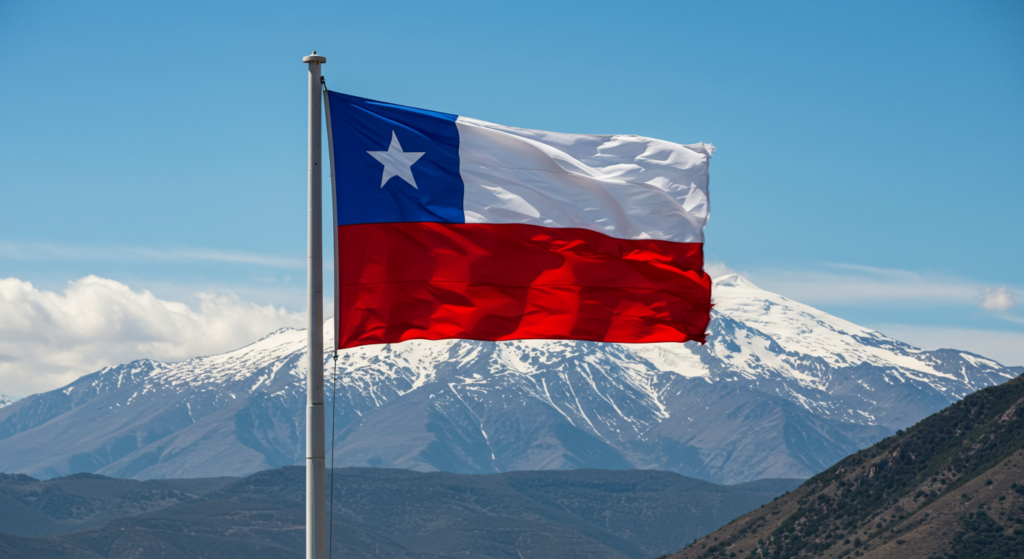
Origins of the Flag
Chile’s flag dates back to the early 19th century. Leaders of the independence movement sought a symbol that could unite the new nation. They considered local motifs and borrowed ideas from existing designs. Eventually, the current layout formed: a five-pointed star on a blue square and two horizontal stripes of white and red.
Some historians note that the star may represent guidance or unity. Others associate it with national heroes. The design took on deep significance as Chile battled for recognition. The flag’s colors soon appeared in uniforms, banners, and official documents. Citizens learned to see them as a sign of freedom and identity.
Red, White, and Blue
Red typically honors the blood shed during independence fights. White can link to the snow-covered Andes, and blue might celebrate the wide skies or ocean waters. Together, they capture Chile’s varied terrain and the spirit that united it. Schools teach these associations to children from an early age.
When Chilean athletes compete abroad, the flag’s colors mark their uniforms. During national holidays, streets fill with these hues. Banners hang from doorways, and small flags wave on cars. Many businesses dress their storefronts with the design. Patriotism flows freely, and the entire country glows in red, white, and blue.
Though the colors are straightforward, their meaning runs deep. They remind the people of the land’s challenges and triumphs. They also symbolize collective goals. Tourists can see flags everywhere, from major intersections to tiny villages. This broad display keeps the national identity vivid.
Patriotic Significance
Military parades on September 19, known as the “Day of the Glories of the Army,” showcase the flag. Soldiers march, bands play, and crowds cheer. The ceremony underscores the country’s connection to its armed forces and the sacrifices made throughout history.
Yet patriotism is not confined to official events. During soccer matches, fans wave giant flags in the stands. In neighborhoods, families hoist flags outside their homes. This sense of collective pride can unite people across political divides. It brings to mind the struggles that shaped Chile’s modern face.
Whether on official papers, sports jerseys, or festival decorations, the flag’s hues resonate. They serve as a reminder of Andean peaks, desert stretches, and ocean horizons. Each color ties back to a piece of Chile’s character, representing courage, natural beauty, and solidarity.
Cultural Expressions and Crafts
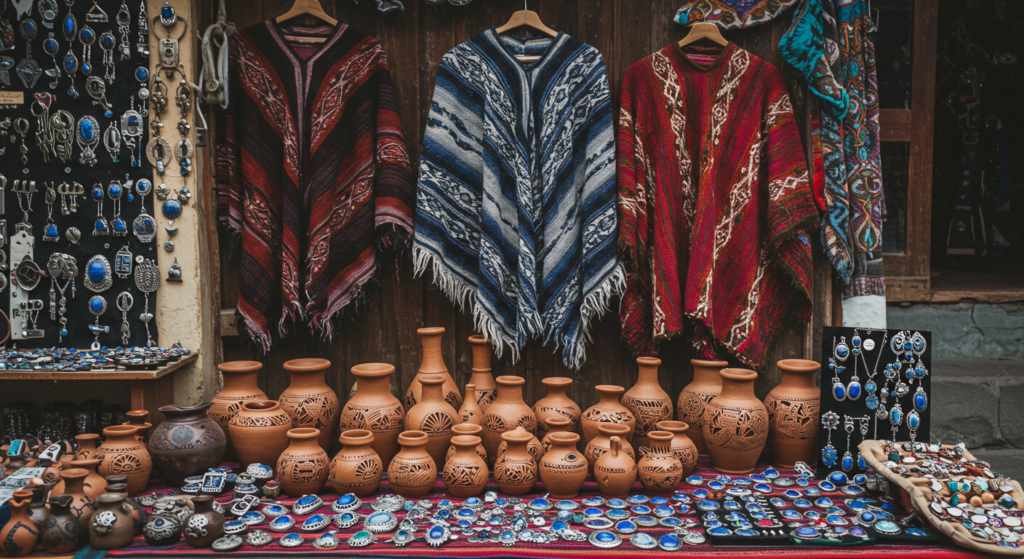
Weaving and Textiles
Chilean weavers produce ponchos, blankets, and tapestries using wool from sheep, alpacas, or llamas. Some designs trace back to pre-Hispanic techniques. Others reflect Spanish colonial influence. The color schemes often include earthy browns, deep reds, and soft whites. Patterns might depict geometric shapes or stylized animals.
Rural artisans spin wool by hand, then dye threads with vegetable or mineral pigments. The result is a rich palette. These pieces keep families warm during cold Andean nights. They also become cherished gifts or souvenirs. In markets, you may find weavings that blend ancient motifs with modern flair.
Weaving cooperatives help preserve this knowledge. Younger generations learn from elders, extending a lineage of artistry. Buyers support these communities by appreciating handcrafted items. Besides providing income, this practice protects cultural memory. Each woven piece carries a small piece of Chile’s spirit.
Ceramics and Pottery
Clay pots, plates, and figurines form another side of Chilean craftwork. Many workshops sit close to regions with abundant clay deposits. Craftsmen shape vessels by hand or using simple wheels. Kiln firing transforms the clay, locking in earthy tones.
Some artisans polish surfaces with smooth stones. They may decorate with delicate patterns. Glazing can add subtle gloss or color, though some pieces retain their natural matte look. These ceramic goods serve everyday uses like cooking or storage, but they also hold decorative appeal.
Ancient influences appear in certain styles. Patterns can echo Andean iconography. Others incorporate coastal themes, referencing fishing or marine life. There is a respect for the raw material, which ties pottery to local land. Each piece feels anchored to specific terrains, bridging past and present.
Metalwork and Jewelry
Chile’s mineral wealth shapes metal arts. Copper remains the key export, but local artisans also work with silver, bronze, and gold. Workshops can be found in major cities or small towns near mining zones. Craftsmen hammer sheets into decorative objects or shape jewelry that sparkles with hand-cut stones.
Silver filigree is popular in the south, where skilled makers twist fine wires into delicate patterns. Bracelets, earrings, and pendants showcase swirling motifs. These items pair well with Chilean gemstones like lapis lazuli, a deep blue rock famously mined in the Andes.
Some pieces reference the star from the national flag or echo Mapuche symbols. Artisans may sign their work, granting a unique touch. Tourists interested in authentic souvenirs often seek out these metal crafts, supporting small businesses while taking home tangible reminders of Chile’s rich earth.
Regional Festivals and Ceremonies

North
Festivals in northern Chile revolve around religious events, harvests, and local saints. Town squares become gathering spots for parades and processions. Participants dress in outfits that combine Spanish tradition with indigenous flair. Musicians play brass instruments, while dancers swirl in swirling costumes.
The Fiesta de La Tirana stands out. Pilgrims travel to the small town of La Tirana for days of dance and devotion. Masks and bright fabrics fill the streets, representing mythical characters. Drums echo late into the night. The desert’s neutral shades contrast with the vibrant outfits worn by celebrants.
Rural life also spawns smaller feasts that celebrate water or farmland blessings. Communities pray for rain, mindful of the desert’s dryness. They give thanks for livestock and meager but meaningful harvests. Visitors find a different kind of spectacle: one that blends faith, tradition, and survival in a stark land.
Center
In central Chile, many festivals showcase wine harvests, coastal customs, or patriotic gatherings. During vintage season, vineyards hold harvest fairs, inviting people to stomp grapes and enjoy folk music. Folkloric groups perform cueca, Chile’s national dance. Tents serve roasted meats, empanadas, and fresh fruit.
Coastal events might include sea blessings. Priests venture on fishing boats, sprinkling holy water. Onshore, families watch or pray for good catches. Local men and women wear maritime-themed clothing. The waves roll in, reflecting the group’s hope for safe journeys.
National holidays bring a grand celebration in Santiago and smaller cities. Military parades, rodeos, and open-air cookouts fill the calendar in September. Flags wave from homes and storefronts. Children learn traditional games with kites and spinning tops. The center’s mild climate encourages large gatherings in parks or town squares.
South
Southern Chile’s festivals highlight Mapuche customs, German-influenced traditions, and rural fairs. Some communities organize Mapuche ceremonies that honor the earth and ancestors. Drums and chants echo through the woods, revealing a profound connection with nature.
In zones with German heritage, like the Lake District, you might find events featuring beer and pastries. Wooden chalets line the streets, adding a European touch to the landscape. Folk dancers perform, and brass bands play in open-air plazas. Locals fuse these roots with Chilean culture, forging a unique hybrid.
Rural fairs often involve livestock shows, wood-chopping competitions, and homemade products. Farmers display cheeses, sausages, and honey. Craftsmen sell carved wood decorations or knitted sweaters. Children run around, sampling treats. These fairs let communities exchange goods and keep cultural ties strong.
Chilean Cuisine and Colorful Dishes
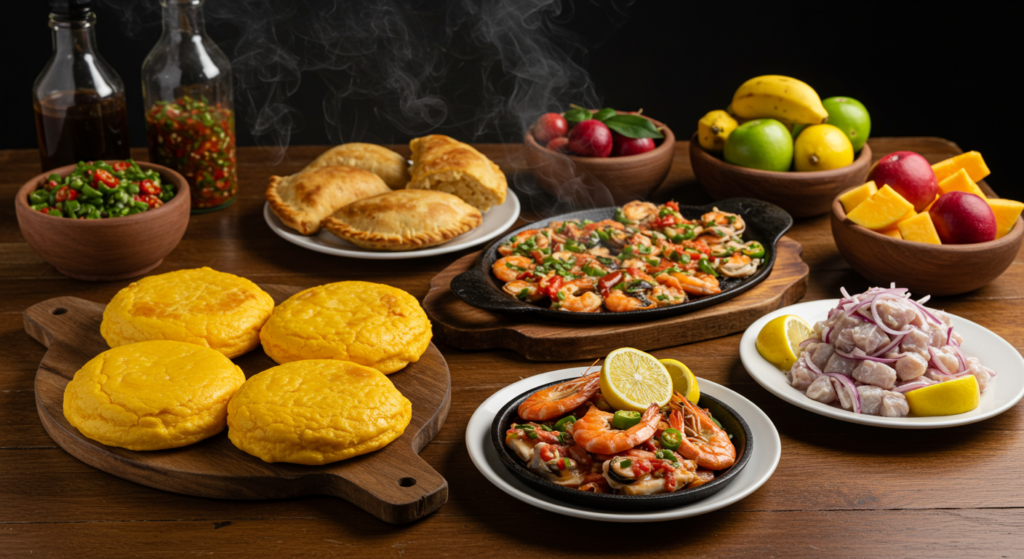
Staple Ingredients
Chilean cooking features grains, legumes, vegetables, and a variety of meats. Corn forms the base for many dishes, like pastel de choclo, a baked pie. Potatoes, native to the Andes, appear in soups or mashed sides. Beans pair with pumpkin in hearty stews.
Seasoning remains moderate, though pebre sauce adds a zesty twist. It includes chopped onion, tomato, chili, and cilantro. Bread, such as marraqueta or hallulla, often accompanies meals. The country’s agricultural range ensures fresh produce most of the year, especially in central valleys.
Traditional recipes tend to highlight natural flavors. Coastal areas serve fish, shrimp, and shellfish, while inland kitchens favor beef or poultry. Fruits like grapes, peaches, and apples flourish, leading to juices, jams, and desserts. Sweet touches appear in pastries or caramel sauces, making the most of local sugar sources.
Coastal Delights
Seafood thrives along Chile’s extensive coastline. Ceviche, though often linked to Peru, appears in Chilean versions that use firm white fish mixed with citrus, onions, and cilantro. Locals eat it chilled, scooping it up with crackers or bread. Another highlight is caldillo de congrio, a savory eel soup praised by literary figures.
If you venture to fishing coves, you might see fresh clams or mussels grilled with cheese. Empanadas de mariscos wrap shellfish in dough and get fried or baked. Each coastal region puts its spin on classic recipes. Some add a dash of local spice or garnish with seaweed for a fresh crunch.
Markets display fish stands with a rainbow of species. Sellers fillet them on the spot. Locals shop early to catch the best cuts for family lunches. Restaurants near the shore often deliver stunning harbor views. Diners watch boats bobbing as they enjoy tangy maritime flavors.
Highland Creations
In Andean zones, the altitude affects cooking choices. Soups and stews simmer for hours, blending potato, pumpkin, and leftover meat. Warming dishes help battle chilly nights. Charqui, a type of dried meat, extends shelf life and provides protein for journeys through rugged terrain.
Quinoa, now famous worldwide, originated in Andean fields. People cook it as a side dish, or incorporate it into salads and soups. It adds a subtle nutty taste and a fluffy texture. Alpaca or llama meat appears in some northern regions, though many families prefer goat or lamb due to milder flavor.
Cheese from goat or sheep’s milk can be found in mountain communities. It pairs well with rustic bread and tomato slices. These highland meals rely on local products, shaped by centuries of tradition. They offer a nourishing taste of Chile’s alpine character.
Literature and Historical Narratives
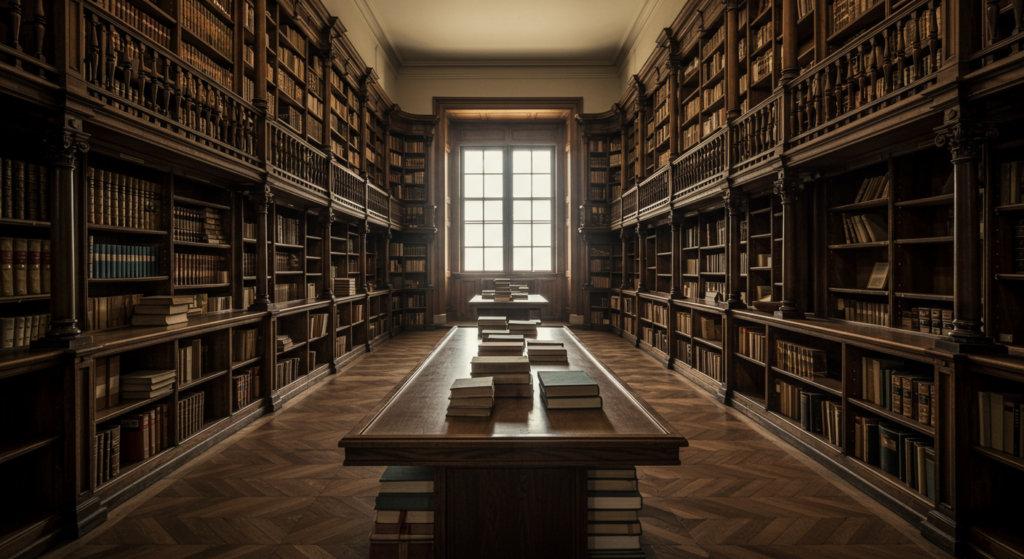
Colonial Chronicles
Chilean literature began with chronicles that described new lands for Spanish readers. Priests and explorers wrote about indigenous communities, flora, and fauna. Many texts praised the region’s potential, although they sometimes included biases against local beliefs.
These writings preserve early details of life in the colonies. They mention building processes, struggles with weather, and trade. They also highlight cultural clashes. Modern scholars examine these documents, searching for new angles. This helps us understand how colonial Chile formed.
Some chronicles celebrate the landscape’s wonders, from snowy summits to the shimmering desert horizon. The best ones capture moments that shaped the colony’s course. They paint a vivid portrait of the hardships and hopes that defined that era.
Romantic Movements
During the 19th century, Romanticism found its way into Chile. Poets and novelists wrote about patriotism, unspoiled nature, and personal freedom. They praised mountain peaks and lonely deserts, framing them as symbols of a brave new country. Their words fed the push for independence.
Writers explored folk tales and legends, weaving them into their stories. Characters might trek across steep passes or sail along stormy coasts. Dramatic backdrops mirrored emotional or political tension. Through these works, Chilean landscapes took on new life in the popular imagination.
This literary wave sparked national pride. It also paved the way for realistic styles that followed. As the country changed, authors shifted to gritty depictions of city life, social inequalities, and labor issues. Yet Romantic echoes lingered, reminding readers that nature and heritage still shaped Chile’s soul.
Contemporary Authors
Modern Chilean writers address diverse themes, from personal identity to political memory. Some authors gain international acclaim, winning prestigious awards. Others focus on local communities, capturing everyday struggles. Their books range from gritty urban tales to whimsical magic realism.
Translators spread these stories abroad. Readers learn about Chile’s dictatorship era, diaspora experiences, or family sagas spanning generations. Literary festivals in Santiago or regional capitals invite established and emerging voices to share their works.
Libraries and independent bookstores thrive in major cities. Younger readers discover local talents, sometimes via digital platforms. Chile’s literary scene feels dynamic, bridging tradition and innovation. Contemporary authors often reach back to historical motifs or native heritage for inspiration, proving the past still matters.
Music, Dance, and Local Rhythms
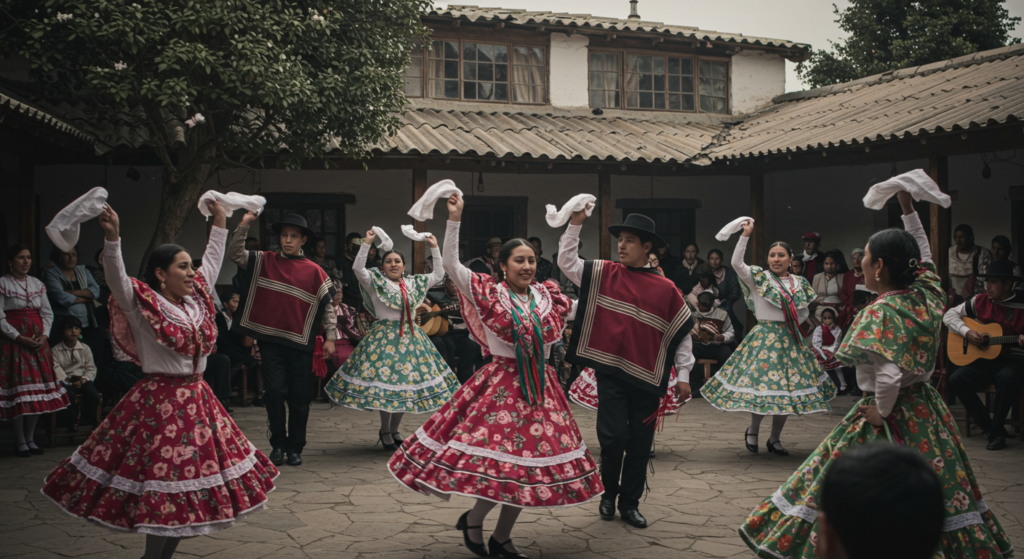
Folk Traditions
Chilean folk music includes cueca, a lively partner dance. Participants wave handkerchiefs and move in a flirtatious pattern. Guitars, accordions, and drums supply the beat. The dance symbolizes courtship. It also appears at parties and national celebrations, stirring group spirit.
Rural tunes often highlight farming life, love stories, or comedic twists. Singers might wear traditional outfits with hats and ponchos. They pass songs down through generations, sometimes adapting the lyrics. The rhythms vary by region. Northern tunes might include Andean instruments, while southern ones incorporate accordions from European influence.
Music accompanies religious festivals too. Brass bands march in processions. Indigenous communities use flutes, small drums, or rattles. These events blend sacred and secular elements, forging a distinctive sound. Enthusiasts can experience this rich heritage at local fairs, peñas (folk gatherings), or community events.
Modern Influences
In big cities, new styles mix with folk traditions. Rock, pop, and electronic music attract younger crowds. Artists sample cueca or folkloric melodies, layering them with modern beats. This fusion revives old genres while reaching fresh audiences. Radios, streaming apps, and clubs help spread these sounds.
Over time, Chile also became home to jazz festivals and classical orchestras. Touring acts make stops in Santiago, broadening musical tastes. Live venues present everything from underground punk to classical recitals. Each scene has its dedicated fans.
Television contests occasionally spotlight undiscovered voices, leading to quick fame. Some find lasting success, while others fade. Still, the cultural bedrock of folk music remains. Even rock bands might include charango riffs or references to cueca in their lyrics.
Regional Variations
Chile’s north leans on pan flutes, drums, and brassy trumpets for festival music. The dryness and altitude shape the tone, granting a bold, resonant style. The center region remains the stronghold of cueca, though variations can emerge in the form of tonadas or country-style ballads.
Down south, German accordions and local rhythms blend in cumbia-style parties. Island regions like Chiloé have lullabies and sea-based tunes. Guitars echo across stilted fishing towns. The environment affects the music’s tempo and mood. Stormy nights might produce somber tunes, while sunny markets bring cheerful melodies.
Travelers who journey through Chile can encounter these changes firsthand. A roadside restaurant may host a folk trio one day, then a reggaeton DJ the next. This variety represents Chile’s openness to external trends and its will to protect homegrown expressions.
Exploring Natural Reserves
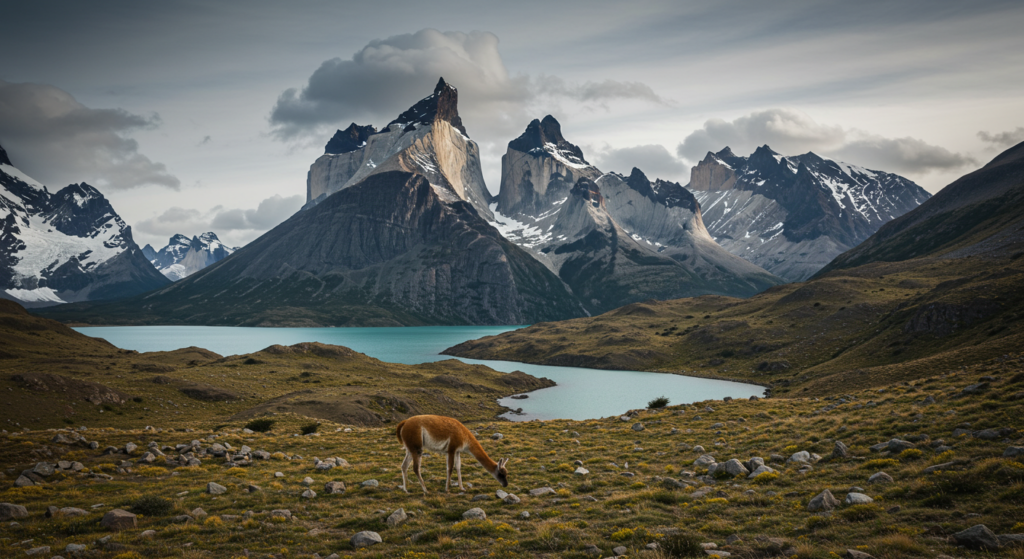
Andean Habitats
Protected areas in the Andes safeguard glaciers, lakes, and rugged wildlife corridors. Backpackers enjoy trails that meander past snow-capped peaks. Guanacos, cousins of llamas, graze on sparse grass. Condors soar overhead, scanning the valleys for prey. These high-altitude zones demand respect.
Some reserves restrict visitor numbers to minimize impact. Rangers monitor trails and educate hikers about flora and fauna. They advise staying on marked paths and packing out trash. The crisp mountain air and sweeping views justify the effort. At sunrise, sunlight on glacier walls can look magical.
Temperatures drop quickly after dark. Campers bundle up, listening to the wind. Streams flow with meltwater, an essential lifeline for downstream agriculture. By witnessing these habitats, you gain insight into Chile’s reliance on mountain ecosystems.
Desert Ecosystems
The Atacama also features protected zones, ensuring fragile desert life remains intact. Conservation areas guard salt flats where flamingos gather. Trails guide visitors through rocky expanses. Educational panels explain how certain plants and animals endure extreme dryness.
Tour companies bring small groups to watch geysers at dawn. Steam rises from geothermal vents, creating an otherworldly scene. Minimal rainfall means footprints may linger. That’s why rangers insist on careful steps, to avoid damaging fragile surfaces. You see rock towers shaped by eons of wind erosion.
Night tours focus on stargazing. Guides set up telescopes, pointing out constellations rarely visible in city skies. The silence of the desert deepens the experience. Stars flicker in a velvety blackness. It’s a humbling reminder of how the desert opens a window to the cosmos.
Coastal Zones
Coastal reserves protect marine life and shoreline habitats. Penguins nest along rocky cliffs, and sea lions bask on hidden beaches. Kayak tours explore calm inlets, giving close-up views of curious dolphins. Offshore, whale-watching excursions track migrating giants. These settings teach respect for marine ecosystems.
Many reserves welcome volunteers who help with beach cleanups or wildlife surveys. Scientists tag sea turtles, gather data on fisheries, or study kelp forests. The ocean sustains local economies, so stewardship matters. Trash from distant shores can wash in on ocean currents, highlighting the connectedness of our world.
Chilean law increasingly emphasizes environmental protection. Marine parks extend far from the coast, preserving underwater riches. Visitors who choose responsible operators can see these wonders in a low-impact way, ensuring future generations enjoy them too.
Practical Tips for Visitors

Travel Logistics
Chile’s international airport in Santiago serves as a gateway. From there, buses or regional flights can reach distant spots. Because the country is long, planning an itinerary requires careful thought. A north-to-south trip might involve big leaps, whether by plane or multi-day bus rides.
Booking in advance helps secure cheaper fares, especially for flights. Major roads run the length of Chile, though mountain passes might close during heavy winter snowfall. Some rural routes can be bumpy. Rental cars are an option, though gas stations may be sparse in remote areas, so plan ahead.
Hotels and hostels cater to different budgets. In popular tourist zones, you’ll find plenty of choices. Smaller towns may only have guesthouses. Reserving early is wise, especially during festivals or peak holiday seasons.
Weather Preparedness
Chile’s climate fluctuates by region and altitude. The north stays dry, with scorching days and cool nights. The center has a Mediterranean climate. Summers there can be hot, while winters bring moderate rain. Southern areas get heavier rainfall and colder temperatures, with snow possible.
Layering clothes is your best bet. You might start the day in a parka if you’re in the mountains, then shed down to a T-shirt by midday in a lower valley. Waterproof gear is vital in the south. Sunscreen matters throughout Chile, especially in the desert or high altitudes where UV rays intensify.
Seasons are reversed compared to the Northern Hemisphere. Chile’s summer runs from December to February, which is popular for beach visits and hiking. Winter, from June to August, can be ideal for ski resorts. Checking weather forecasts close to departure is smart, since conditions can shift without warning.
Cultural Etiquette
Chileans greet one another with a handshake or a cheek kiss, depending on context. In business settings, stick to a handshake. Among friends or informal gatherings, lean in for a quick cheek contact. Politeness and small courtesies go a long way. Saying “gracias,” “por favor,” and “buenos días” helps you fit in.
When dining, it’s common to keep your hands on or above the table. Wait for the host to begin eating. If you’re invited to a home, bringing a small gift like sweets or a beverage is kind. Dress codes vary: major cities may favor casual but neat clothing, while upscale places can expect something a bit dressier.
Be respectful of cultural traditions. Locals might have strong opinions on sports or current affairs, so be ready for lively chats. If you visit indigenous communities, follow local customs, which can include seeking permission before taking photos. A little extra care shows your respect for Chilean society.
Conclusion

Chile weaves together snowy Andes, sun-scorched deserts, and a sprawling Pacific shore. Each region brings its own spectrum of whites, neutrals, and blues, reflecting the wild range of landscapes. History also shapes this color palette. Indigenous legacies, colonial structures, independence movements, and modern shifts converge into a story as varied as the terrain.
Architecture, crafts, and festivals carry these colors forward. The national flag itself—bright red, clean white, and bold blue—stands for independence, the Andes, and the ocean’s reach. Whether you explore desert dunes or coastal inlets, you see how each zone adds a distinct chapter to Chile’s identity.
This journey encourages you to look deeper. Instead of focusing on only the most famous spots, see the interplay of people and environment in the lesser-known corners. From starry desert skies to glacier-fed lakes, Chile’s colors gleam across countless miles. With a bit of preparation and a sense of wonder, you can uncover the stories behind each hue.
Summary Table

| Element | Key Points |
|---|---|
| Andean Whites | Permanent snows, glaciers, cold peaks, resource for water and hydropower. |
| Desert Neutrals | Atacama’s dry expanse, minimal rainfall, salt flats, mining heritage. |
| Pacific Blues | Rich coastline, fishing economy, maritime culture, from sunny beaches to fjords. |
| Historic Legacy | Colonial rule, independence era, diverse European and Indigenous influences. |
| Architecture | Mix of colonial adobe, modern skyscrapers, colorful coastal houses. |
| Flag Colors | Red for independence, white for snowy peaks, blue for skies/oceans. |
| Crafts | Weaving (wool, alpaca), ceramics, metalwork with copper, silver, and lapis. |
| Festivals | Religious parades, regional dances, harvest fairs, city-wide celebrations. |
| Cuisine | Seafood along coast, hearty Andean stews, iconic corn dishes, fresh produce. |
| Literature | Colonial chronicles, Romantic writings, modern novels reflecting social issues. |
| Music & Dance | Folk cueca, blend of modern trends, regional variations in instruments. |
| Natural Reserves | Protected areas in mountains, deserts, and ocean, home to diverse wildlife. |
| Visitor Tips | Plan transport carefully, bring layers for climate changes, mind cultural norms. |
| Overall Identity | Fusion of extremes, bridging ancient customs with modern progress. |
FAQ
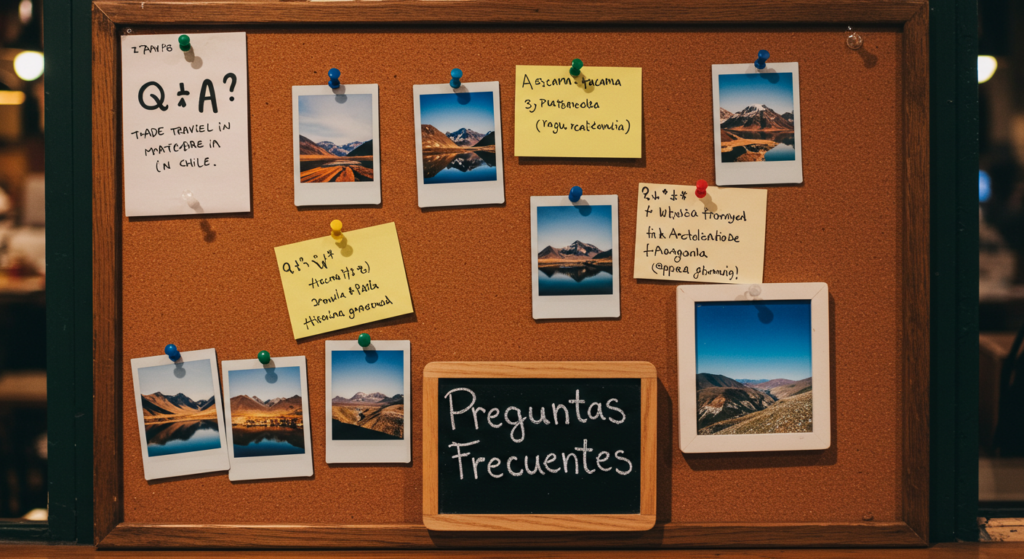
Q: What is the best time to visit Chile?
A: It depends on where you plan to go. The north is pleasant year-round. The center is hot in summer (December–February) and mild in winter. Patagonia is ideal in spring or summer, when days are longer and trails are accessible.
Q: How can I see the desert blooms in the Atacama?
A: In years with more rainfall, certain parts of the Atacama experience a flowering phenomenon. Watch weather reports. When conditions are right, wildflowers blanket the desert. Local guides can direct you to prime viewing spots.
Q: Is Chile safe for solo travelers?
A: Chile is considered one of the safer countries in South America. City centers, however, can face petty crime like pickpocketing. Stay alert in crowded places, keep valuables hidden, and use common sense. Many travelers explore alone with few issues.
Q: Which local dishes should I try first?
A: Some favorites include empanadas (filled pastries), pastel de choclo (corn pie), and fresh seafood like ceviche or caldillo de congrio. In the south, sample curanto (a stew that involves shellfish and meat). Save room for sweets like alfajores or mote con huesillo (peach-based drink).
Q: Do I need Spanish to travel around Chile?
A: Knowing basic Spanish helps a lot, especially outside major tourist areas. Many locals speak only minimal English. However, in larger cities and top attractions, you can often find bilingual guides or resources.
Q: Can I explore Patagonia without joining a tour?
A: Yes. Some travelers rent cars or use regional buses. Still, big parks like Torres del Paine benefit from guided visits if you lack experience in wilderness hiking. Roads and weather can be tricky, so prepare carefully.
Q: Are there unique souvenirs to bring home?
A: Look for woolen textiles, lapis lazuli jewelry, and copper crafts. Folk art from specific regions, such as Mapuche carvings or Atacama pottery, can also be memorable keepsakes. These items reflect local skills and heritage.
Chile’s Andean colors—white summits, desert neutrals, and Pacific blues—create a striking palette that guides you from one border to another. Each region’s identity emerges through its landscapes, customs, and vibrant art forms. When you explore this long country, let its colors show you how history, geography, and local spirit come together in remarkable ways.

Sam Goldman, with his intuitive grasp on the art of color selection, navigates the vibrant tapestry of fashion shades, ensuring each ensemble reflects the pulse of modern trends. His knack for crafting unique yet cohesive color combinations unravels the complexities of the fashion spectrum. Beyond being a mere sentinel, Sam’s dedication transforms every reader’s wardrobe journey into a harmonious blend of contemporary elegance and timeless allure. Dive into his writings and emerge with a refreshed perspective on fashion colors.
Reviewed By: Joanna Perez and Anna West
Edited By: Lenny Terra
Fact Checked By: Matthew Mansour
Photos Taken or Curated By: Matthew Mansour
